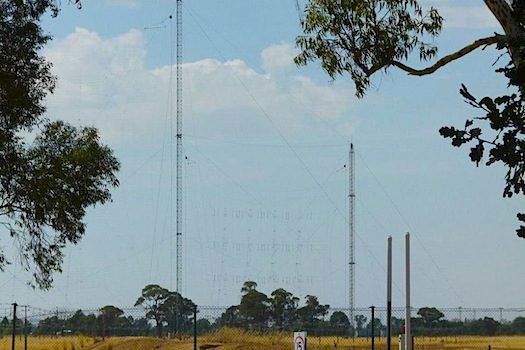The Department of Communications and the Arts (DOCA) has released its Review of Australian Broadcasting Services in the Asia Pacific, almost a year after it was submitted.
The 210 page review examines the ABC’s decision to pull out of shortwave broadcasts in the Pacific and reviews other broadcasting services in the region. It was conducted jointly by DoCA and the Department of Foreign Affairs and Trade (DFAT) with assistance from the Sapere Research Group.
The review’s objective was to assess the reach of Australia’s media in the Asia Pacific region, including examining whether shortwave radio technology should be used. It covered all analog, digital and satellite distribution platforms, including television, radio and online, across all types of service (commercial, community and publicly funded).
A total of 433 submissions were received, from Australia, countries in the Asia Pacific region and the United Kingdom, Germany, the United States of America and Peru.
Most submissions focused on issues surrounding broadcasting to the Pacific, with seven explicitly discussing Asian markets.
We examine how the report summarised the major submissions:
Many submissions expressed concern that successive budget cutbacks have caused reductions in Australia’s supplies of international broadcasting services, particularly to the Pacific. Consequently they advocated for the revitalisation of those international services, including alternative models for delivery and governance of Australian government funded international broadcasting services.
The majority of submissions, which focused on the Pacific, advocated the restoration of ABC’s shortwave services in the Pacific region.
Submissions that were in favour of restoring shortwave services disputed the views that the technology has “limited and diminishing audiences” and disproportionately high costs.
Submissions highlighted the significant variation of media markets across and within countries of the Asia Pacific region. This included the highly competitive nature of some markets in Asia and dramatically changing historical patterns of media usage, which requires the use of a flexible “narrowcasting” approach that tailors content and distribution platforms to be fit for purpose for the target audiences in each country.
The review details the various views expressed, but makes no firm conclusions or reocmmendations on action to be taken.
Many submissions were of the view that the cessation of ABC’s shortwave services is due to successive budget cuts. This was reflected in the ABC’s submission, in which they stated that budget cuts in 2014 “significantly reduced the ABC’s ability to deliver optimal international services.”
Submitters taking this viewpoint expressed concern at the erosion of technical and journalistic expertise, “cultural intelligence” and regional networks. Several commented on the resulting decline in ABC’s reach across the region, noting that Radio Australia broadcasts are now unavailable in ten of the 18 Pacific Island Forum nations.
Several individual submitters described how Radio Australia’s broadcasts were highly valued, respected and trusted by those living in the Pacific. Sean Dorney, a former ABC correspondent in the Pacific, observed that in many places the broadcasts were regarded as “essential, trustworthy and reliable”.
Those submitters who commented on the Asian markets noted that it is a crowded broadcasting space. Murray Green, former Director International at ABC, commented that gaining impact and engagement in these markets would require a “significant commitment to relevant content, effective distribution and marketing”. Professor Wanning Sun commented that making good use of the diasporic language media in Australia is an important tool of Australian public diplomacy.
Many submissions regarding the Pacific markets were of the view that locally-relevant and culturally resonant content is necessary to engage with a broad cross-section of people in these countries. Several commented that programing in local languages was also important—citing Melanesian Pidgins such as Tok Pisin as having particularly broad reach and importance for national cohesion.
SBS noted the extent of its multilingual content production as Australia’s multicultural public broadcaster.
Submitters who were in favour of restoring shortwave services disputed the ABC’s claims (including those in their submission to the Senate Environment and Communications Legislation Committee) regarding that the technology has “limited and diminishing audiences” and disproportionately high costs. Many did not agree that FM is a suitable replacement for countries with difficult mountainous terrain, such as Papua New Guinea.
Several expressed concern with the audience statistics cited by the ABC, in particular those relating to audiences in PNG, and assumptions around access to alternative platforms, particularly in Pacific Island Countries.
Some submitters who had lived and worked in the Pacific commented that FM broadcasts are unavailable to people living outside the main urban centres, which in some countries such as PNG accounts for a large majority of the population. Some also explained the limited affordability and availability of satellite and internet communication services for large proportions of the population in the Pacific. The Secretary General of the Pacific Islands Forum Secretariat, Dame Meg Taylor, submitted that:
In time, the necessity of shortwave technology may fade, however it should only do so once suitable alternatives are accessible to all in the Pacific. Too many of our people rely on shortwave technology, and I stress the need for Australia to strongly consider restoring the services for those that depend on it during times of both normality and crisis.
Geoff Heriot, former ABC correspondent and senior executive, submitted that declining household access in PNG to media overall was partly due to declining signal reliability of local services. Other individual submitters, Graeme Dobell (former ABC reporter and currently Journalist Fellow with the Strategic Policy Institute) and Peter Marks (former ABC technology editor), commented that ABC’s signal strength was too low-powered, meaning broadcasts were inaudible to listeners. Marks also submitted that the broadcasts were on frequencies that could not be received by most car radios in the Pacific.
Several submitters commented that other international broadcasters continue to see value in shortwave, with the BBC, Radio New Zealand Pacific and China Radio International expanding their services. Submitters noted that both the BBC and Radio New Zealand have upgraded their shortwave services through the use of Digital Radio Mondiale (DRM).
Using information supplied by the ABC on its expenditure on those shortwave broadcasts, the Review estimated that since 2007–08, Australia has incurred $80.6 million of economic costs (expressed in 2018–19 dollars), in order to provide shortwave radio broadcasts to the Asia Pacific region. This included:
- $30.1 million of expenditure on providing shortwave broadcasts to Asia
- $44.5 million of expenditure on providing shortwave broadcasts to the Pacific, and
- $6 million of economic costs that Australia incurred in order to raise the taxation revenue required to fund those broadcasts.
Using that information, it is estimated that since 2007–08, Australia derived $120.9 million of benefits (expressed in present value terms), from its provision of shortwave radio broadcasts to the Asia Pacific region, which included:
- $48.8 million of benefits from providing shortwave broadcasts to Asia, and
- $72.1 million of benefits from providing shortwave broadcasts to the Pacific.
By deducting the estimated economic costs of supplying those shortwave broadcasts from those estimated economic benefits, it is estimated that since 2007–08, Australia derived $40.3 million of net benefits from its shortwave broadcasts to the Asia Pacific region.
The review was inconclusive about the economic benefits of shortwave broadcasting.
The report says: “In the absence of a clear statement of the objectives Australia’s Asia Pacific broadcasts and a clear articulation of the full range of alternative options for achieving those objectives, it is not possible to determine whether Australia would derive a net benefit from resuming its shortwave broadcasts to the Asia Pacific.”
The Government is also reviewing its approach to Soft Power in two other reviews, which are expected also to comment on the delivery of shortwave and other media services to the Asia Pacific.
In assessing the future demand for services, the review seems to focus on the willingness of audiences to pay for services, which is strange, considering that shortwave radio is free. The review says:
“Whereas Australian broadcasters originally used to have to rely on shortwave radio broadcasts for direct reach to their Asia Pacific audiences in the past, they now have a much wider range of direct and indirect broadcasting platforms to use (e.g. satellite TV broadcasts, rebroadcasting through local AM and FM radio stations, TV stations, and online content streaming over the internet). Although some audiences are more difficult and costly to reach (e.g. audiences in the more remote areas of the Asia Pacific region), those audiences only comprise a very small proportion of the actual and potential demand for Australia’s broadcasts.”
The report lists the main barriers that continue to constrain the reach of Australia’s broadcasts as:
- ability of Asia Pacific audiences to understand Australia’s broadcasts. Since there are significant differences in the languages that are spoken by the audiences in Australia’s diverse Asia Pacific markets for its broadcasts, the use of one language (e.g. English, which is the predominantly language used by most of Australia’s Asia Pacific broadcasts) continues to constrain both the potential and actual demand for those broadcasts, and
- willingness and ability of Asia Pacific audiences to pay for Australia’s Asia Pacific broadcasts, which largely depends on the extent to which they find the content of Australia’s broadcasts interesting and entertaining in relation to the content of other competing broadcasts.
There are no formal recommendations for action, only a finding that the Government “clarify the objectives of its Asia Pacific broadcasts… in achieving Australia’s broader strategic policy objectives, as well as the target audiences for those broadcasts.”
The full report can be downloaded here.



The ABC is one method of soft power for our Asian-Pacific brothers and sisters.
Conventional AM, FM and SW receivers are ubiquitous. For the former two, the AM and FM services a local transmitter relays the ABC signal via satellite. However, FM whose VHF carrier is line of sight may not be suitable for hilly terrains as mentioned in the story.
Then to our northern neighbours in PNG, the report that even their local services have a weak sound implying low level AM transmission informs us that for Australia to have its presence felt is to broadcast a strong signal.
The resumption of SW services may well be answer. It is more likely that a village in PNG or the Pacific Islands will have a SW-AM receiver rather than a SW-DRM receiver. DRM signals are digital and have the necessary error-correction codes transmitted as part of the content information. This should result in a cleaner reception compared to the fading in and out of the signal under conventional AM SW reception.
If the ABC was to transmit SW using DRM, then our government as part of its soft power should include subsidising the export of SW DRM receivers as part of its aid budget. It would be more efficient to transmit a few signals in SW DRM than planting AM and FM relay stations all over the Asia-Pacific region.
It is imperative that Australia maintain soft relations with its Asian-Pacific neighbours otherwise some other power will fill the void with its own agenda.
Thank you,
Anthony of exciting Belfield